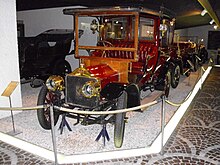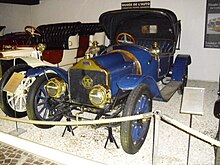Bodywork Georges Gangloff
| Bodywork Georges Gangloff | |
|---|---|
| legal form | Limited partnership |
| founding | 1903 |
| resolution | 1936 |
| Seat | Geneva , Zurich , Bern ( Switzerland ), Colmar ( Alsace , France ) |
| management | Georges Gangloff |
| Branch | Metal processing, body construction |
Carrosserie Georges Gangloff was a Swiss body construction company . Gangloff AG in Bern , which is still active today, emerged from the company that went out in 1936 .
Company history
The company's roots go back to 1830 when the construction of carriage components such as wheels and hubs and complete vehicles began. In 1878 the cartwright was formally established in Geneva and managed by the brothers Georges and John Gangloff . This resulted in the Gangloff body shop in 1903 , with which the Gangloffs entered the growing market for car bodies. Gangloff was the main supplier for the Geneva car manufacturers Société des Automobiles à Genève (SAG) and Piccard-Pictet ( Pic-Pic ). Soon after, the brothers separated. While Georges continued to run the business alone and moved into larger facilities in the Sécheron district of Geneva , John opened his own body shop in Lausanne , J. Gangloff & Cie. It is known that his company also made bodies for Pic-Pic; however, his company was taken over by F. Borgatta & Fils as early as 1912 .
The Geneva operation was reorganized as Georges Gangloff SA after the separation from John . With 120 employees, it was already one of the largest companies of its kind in Switzerland in 1914 and one of the few that also enjoyed international attention. After the First World War , the company developed into a leading specialist for car bodies in single and small series production. In 1928 the company moved into the new Swiss headquarters in Bern .
Colmar

In order to better participate in the important French market for special bodies, Gangloff established a foothold in France as early as 1919 and set up an increasingly independent branch in Colmar ( Alsace ), where unneeded space was rented to the Carbody Wiederkehr located there. In 1927 Gottlieb Moor and Paul Horlacher jointly became managing directors of the Gangloff body shop (Colmar) ; both had previously worked for the Swiss company. Because of the impressive number of bodies for Bugatti, this company ultimately became better known than the parent company. Gangloff Colmar has bodyworked more Bugatti Type 57 than all the other independent bodybuilders put together. The design in Colmar was developed independently of that in Switzerland; much was given by Jean Bugatti , even if only sketched . In 1930 the car body was taken over.
Gangloff Colmar did not cope with the decline of Bugatti after the Second World War . Attempts were made to switch to chassis from other manufacturers, but these - above all Delage , Delahaye , Hotchkiss , Salmson or Talbot-Lago - survived the collapse of the luxury car market in France as a result of the economic situation, a tax reform in France and technical developments Not. Foreign brands like Rolls-Royce or Bentley did not make enough chassis to keep all, especially French, suppliers in business. Gangloff Colmar was still active in the commercial vehicle and bus sector for a short time before production ended in the 1960s.
Innovations
Georges Gangloff developed a door hinge and holding system that made it possible to use significantly narrower door pillars. All the hinges were on the B-pillar . The aim was to create more elegant structures with better all-round visibility and more light in the interior. These fittings also became known in France through Gangloff Colmar, where they were used under license by various coachbuilders .
Clear vision
The US automobile designer Frank Spring (1893-1959) brought the Gangloff patent to the USA, where it was improved by his employer at the time, the Walter M. Murphy Company in Pasadena (California) , and offered as Clear Vision . Murphy used it mainly for sedans , four-door convertibles ("Convertible Sedans") and Coupé de Villes . It was - somewhat exaggerated - claims that a Clear Vision - A-pillar as the distance between the eyes of the driver is narrower from each other and therefore that not the column is perceived. But it was undoubtedly a step forward compared to the usually massive pillars in closed vehicles and also allowed for a more elegant design with a lighter-looking roof. Murphy also built body-in-white ("In the White"; that is, without painting or interior fittings) for other manufacturers.
C. & R. Geissberger
In 1929 Gangloff took over the C. & R. Geissberger body shop in Zurich, which was also founded in 1903 . Before the First World War, this company was one of the largest Swiss coachbuilders and supplied Martini and Saurer in particular . It appears that complete Gangloff bodies were made at all three locations.
Decline
Gangloff showed a Talbot with sliding doors at the Geneva Motor Show in 1931 and 1932 ; at least in 1931 as a convertible. The severe economic crisis in 1933 meant that Gangloff had to practically give up car body construction entirely; Occasionally, orders were carried out to order. The Swiss government did take measures in the fight against high unemployment, which stipulated the highest possible domestic production share of automobiles, and the import of vehicles with foreign special bodies was very limited. When the house bank went bankrupt in 1936 and Gangloff was unable to meet obligations, the solidly managed company was liquidated.
In the same year, the Carrosserie de Sécheron SA , named after the Geneva location district , was built in its facilities in Geneva . The founders were two Gangloff executives, the former technical director Robert Grau and Edouard Fischer , previously responsible for Gangloff's finances,
Sécheron built some very elegant bodies, mostly convertibles, for Delahaye and Jaguar . The company existed until 1967.
The branch in Bern was founded by Dr. R. von Muralt bought and self-employed as Neue Carrosserie Gangloff AG . Today it is part of Gangloff AG as Gangloff Trailers and manufactures commercial vehicle bodies and truck trailers.
Used chassis

Gangloff produced most of the bodies for the Swiss manufacturers SAG and Pic-Pic as well as a large number for Martini . Superstructures manufactured by Gangloff are also known on chassis from Ansaldo , Delage , Hispano-Suiza , Hudson , Isotta Fraschini , Mercedes-Benz , Minerva , Rolls-Royce , Terraplane , Voisin and also some from Bugatti , albeit a lot more of these in the branch were built in Colmar.
Trivia
- In the Museum of Transport Switzerland in Lucerne a Pic-Pic-touring car of 1919 with Gangloff body is on display. Saoutchik later modernized the rear of this vehicle .
- The collection of the Gianadda Foundation in Martigny contains a SAG and two Pic-Pic with Gangloff bodies.
literature
- Ferdinand Hediger: Schweizer Carrossiers 1890-1970 , 1st edition 2013, SwissClassics Publishing AG, Bäch SZ (Switzerland); ISBN 978-3-9524171-0-2 , hardcover
- Catalog for the special exhibition The Swiss Carrossiers. in the Pantheon Basel from October 27, 2013 - April 6, 2014.
- Ferdinand Hediger: Classic Cars 1919–1939. Hallwag-Verlag, Ostfildern 1998, ISBN 3-444-10348-4 .
- Roger Gloor: Post War Car. Passenger cars 1945–1960. 2nd Edition. Hallwag-Verlag, Bern / Stuttgart 1982, ISBN 3-444-10263-1 .
- Roger Gloor: Passenger Cars of the 1960s. 3. Edition. Hallwag-Verlag, Ostfildern 1998, ISBN 3-444-10307-7 .
Web links
- Gangloff AG Bern website (accessed on February 4, 2013)
- coachbuild.com: Brief portrait of Carosseries Gangloff (accessed February 4, 2013)
- coachbuilt.com: Walter M. Murphy Co. (accessed February 4, 2013)
- coachbuilt.com: Larkins & Co. (accessed February 4, 2013)
- coachbuilt.com: Frank Spring (1893–1959) (English) (accessed November 14, 2013)
- swisscarregister.ch: Georges Gangloff (accessed on November 15, 2016)
- swisscarregister.ch: John Gangloff (accessed November 15, 2016)
- swisscarregister.ch: C. & R. Geissberger (accessed on November 15, 2016)
- Catalog for the special exhibition Die Schweizer Carrossiers in the Pantheon Basel from October 27, 2013 - April 6, 2014 (accessed on January 8, 2014)
- François Vanaret: L'Âge d'or de la carrosserie française; Carrosseries Saoutchik (French) (accessed September 30, 2014)
- Bonhams auctions: Paris Expo, Porte de Versailles Automobiles d'Exception , February 9, 2008: lot no., 168; Bugatti Type 57 Coach Gangloff, Chassis No. 57546 (English) (accessed February 4, 2013)
- Zwischengas.com: Swiss Car Register with Gangloff special show at OTM Friborg (English) (accessed on September 10, 2013)
- Bénédict Frommel: Société Anonyme des Ateliers de Sécheron. In: Historical Lexicon of Switzerland . (accessed on January 8, 2014)
- GTÜ-Oldtimerservice: Gangloff Colmar (accessed on November 20, 2013)
Remarks
- ↑ Gangloff superstructures are e.g. B. on a Terraplane chassis from 1934 and a Hudson Super Six from 1935 (both as four-door convertibles), so the end of production in 1933 cannot be as absolute as shown in the Swiss Car Register.
Individual evidence
- ↑ Zwischengas.com : Swiss Car Register with Gangloff special show at the OTM Friborg
- ^ A b Bonhams Auctions: Paris Expo 2008 ; Lot 168; Bugatti T57 Coach Gangloff # 57546
- ↑ a b c Hediger: Schweizer Carrossiers (2013), p. 41
- ↑ a b c d e f Swiss Car Register: Georges Gangloff
- ↑ a b c d e f g Catalog for the special exhibition The Swiss Carrossiers in the Pantheon Basel, p. 33 (Gangloff)
- ↑ a b coachbuilt.com: Walter M. Murphy Co.
- ↑ a b coachbuilt.com: Frank Spring (1893–1959)
- ↑ coachbuilt.com: Larkins & Co.
- ^ Swiss Car Register: CR Geissberger
- ↑ Catalog for the special exhibition The Swiss Carrossiers in the Pantheon Basel, p. 36 (Geissberger)
- ↑ a b c d Hediger: Schweizer Carrossiers (2013), p. 47
- ↑ Catalog for the special exhibition The Swiss Carrossiers in the Pantheon Basel, p. 111 (Sécheron)
- ^ Swiss Car Register: Sécheron
- ↑ François Vanaret: L'Âge d'or de la carrosserie française; Carrosseries Saoutchik



